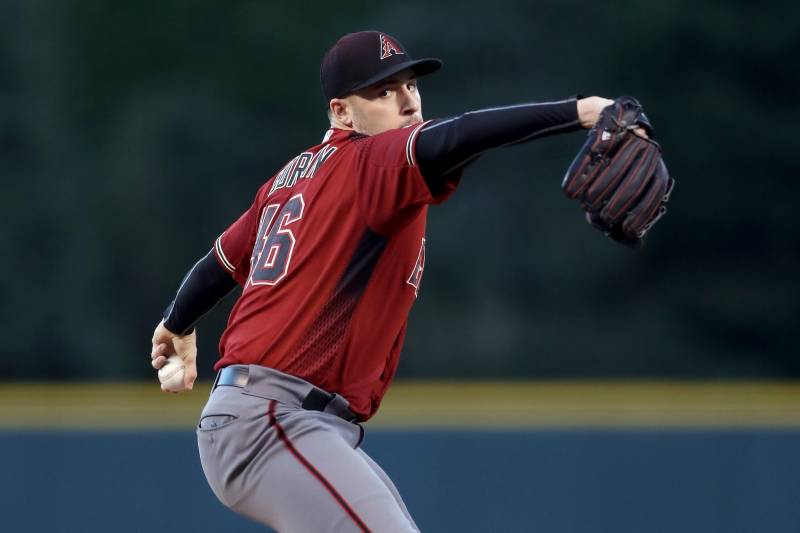Patrick Corbin Is the Looming $125M MLB Free-Agent Bust to Avoid
By ZACHARY D. RYMER
Matthew Stockman/Getty Images
Unlike other top starting pitchers from past Major League Baseball offseasons, it shouldn't cost a team $200 million to sign Patrick Corbin as a free agent. Or even $150 million for that matter.
That doesn't mean he can't become a bust.
Though the Arizona Diamondbacks six-year veteran—not counting 2014, which he missed while recovering from Tommy John surgery—won't cost as much as David Price, Max Scherzer, Zack Greinke or Jon Lester, his price is still going to exceed nine figures. Nick Cafardo of the Boston Globe speculated that something in the five-year, $100-125 million range is in order.
That might sound like a discount after the season Corbin just had.
The left-hander earned his second All-Star nod, as he pitched 200 innings and set new career bests in ERA (3.15), strikeouts (246) and strikeout-to-walk ratio (5.13). The 29-year-old won't win the National League Cy Young Award, but he's bound to get some love from voters nevertheless.
As far as Corbin's free-agent value is concerned, prospective suitors may be especially enthused with how he evolved as a pitcher in 2018.
Before the season, he was a fastball-slider pitcher who got by on the sheer quality of his pitches. Because of a significant dip in the average velocity of his fastball, 2018 might have spelled the death of both that approach and Corbin's time as a top-of-the-rotation starter.
Instead, Corbin altered his pitch mix to feature more two-seamers than four-seamers, plus a brand new curveball that he made up on the spot in an April outing against the San Francisco Giants. He also got hitters to swing and swing and miss at his slider like never before.
That had something to do with how good Corbin was at disguising his slider as a fastball:
As Arizona manager Torey Lovullo said to Zach Buchanan of The Athletic in June: "I think there's finish to [Corbin's] pitches, even though it might not be the same velocity. It's effective. That's all that really matters."
In all, the rate at which Corbin struck hitters out (30.8 percent, to be exact) was no accident. His contact rate was lower than ever before, and it was second only to American League Cy Young favorite Blake Snell among qualified starters.
But while teams will assuredly line up to pay Corbin this winter, prospective suitors should realize his career year wasn't entirely the result of skill.
Consider the disparity between how much batted balls hurt Corbin and how much they should have hurt him. For the first time since 2015, Corbin's expected slugging percentage was higher than his actual slugging percentage, according to Statcast data:
The average launch angle off him was mostly par for the course, while his average exit velocity was up from 2017. Thus, Arizona's efficient defense and the power-suppressing effect of Chase Field's new humidor may have aided him.
This alone is something that Corbin's top suitors need to carefully consider before signing him to a nine-figure deal. That goes double for the New York Yankees and Philadelphia Phillies, specifically. Both struggled on defense in 2018. Both also call a bandbox home.
To wit, quite a few of Corbin's fly balls and line drives that missed being homers at Chase Field would have landed beyond the fence at Yankee Stadium:

Image courtesy of BaseballSavant.MLB.com
The D-backs' home field and defense may not be the only thing Corbin misses if he departs for another team. He's also bound to miss his catchers.
With the help of Alex Avila, Jeff Mathis and John Ryan Murphy, a career-high 10.7 percent of Corbin's takes outside the strike zone resulted in called strikes. In total, only Kyle Freeland and teammate Zack Greinke received more favorable calls outside the zone throughout the year.
Along with his adjusted pitch mix, this helps explain why Corbin was comfortable pitching outside the strike zone more frequently. If those favorable calls go away in tandem with lesser strike framers on a new team, he'll have to go back in the zone more often. If so, his diminished fastball velocity could quickly go from a non-issue to a major issue.
This is where it's worth reiterating that Corbin isn't some kind of clueless hack when he's on the mound. He knows how to use the stuff he has, and he can miss bats with the best of 'em when he's on.
Nonetheless, teams must be wary about believing that Corbin's 2018 dominance is sustainable. A move to another team will likely strip him of the advantages he enjoyed in Arizona, rendering him less of a No. 1 and more of a No. 2 or even a No. 3.
Which is to say: Give him $125 million at your own peril.
No comments:
Post a Comment